Medscape CME Activity
Medscape, LLC is pleased to provide online continuing medical education (CME) for selected journal articles, allowing clinicians the opportunity to earn CME credit. In support of improving patient care, these activities have been planned and implemented by Medscape, LLC and Emerging Infectious Diseases. Medscape, LLC is jointly accredited by the Accreditation Council for Continuing Medical Education (ACCME), the Accreditation Council for Pharmacy Education (ACPE), and the American Nurses Credentialing Center (ANCC), to provide continuing education for the healthcare team.
CME credit is available for one year after publication.
Volume 28—2022
Volume 28, Number 12—December 2022
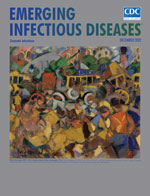
Acinetobacter baumannii is a nosocomial pathogen associated with severe illness and death. Glucocorticoid aerosol is a common inhalation therapy in patients receiving invasive mechanical ventilation. We conducted a prospective cohort study to analyze the association between glucocorticoid aerosol therapy and A. baumannii isolation from ventilator patients in China. Of 497 enrolled patients, 262 (52.7%) received glucocorticoid aerosol, and A. baumannii was isolated from 159 (32.0%). Glucocorticoid aerosol therapy was an independent risk factor for A. baumannii isolation (hazard ratio 1.5, 95% CI 1.02–2.28; p = 0.038). Patients receiving glucocorticoid aerosol had a higher cumulative hazard for A. baumannii isolation and analysis showed that glucocorticoid aerosol therapy increased A. baumannii isolation in most subpopulations. Glucocorticoid aerosol was not a direct risk factor for 30-day mortality, but A. baumannii isolation was independently associated with 30-day mortality in ventilator patients. Physicians should consider potential A. baumannii infection when prescribing glucocorticoid aerosol therapy.
| EID | Zhang W, Yin M, Li W, Xu N, Lu H, Qin W, et al. Acinetobacter baumannii among Patients Receiving Glucocorticoid Aerosol Therapy during Invasive Mechanical Ventilation, China. Emerg Infect Dis. 2022;28(12):2404. https://doi.org/10.3201/eid2812.220347 |
|---|---|
| AMA | Zhang W, Yin M, Li W, et al. Acinetobacter baumannii among Patients Receiving Glucocorticoid Aerosol Therapy during Invasive Mechanical Ventilation, China. Emerging Infectious Diseases. 2022;28(12):2404. doi:10.3201/eid2812.220347. |
| APA | Zhang, W., Yin, M., Li, W., Xu, N., Lu, H., Qin, W....Wang, H. (2022). Acinetobacter baumannii among Patients Receiving Glucocorticoid Aerosol Therapy during Invasive Mechanical Ventilation, China. Emerging Infectious Diseases, 28(12), 2404. https://doi.org/10.3201/eid2812.220347. |
Noncholera vibriosis is a rare, opportunistic bacterial infection caused by Vibrio spp. other than V. cholerae O1/O139 and diagnosed mainly during the hot summer months in patients after seaside activities. Detailed knowledge of circulating pathogenic strains and heterogeneities in infection outcomes and disease dynamics may help in patient management. We conducted a multicenter case-series study documenting Vibrio infections in 67 patients from 8 hospitals in the Bay of Biscay, France, over a 19-year period. Infections were mainly caused by V. alginolyticus (34%), V. parahaemolyticus (30%), non-O1/O139 V. cholerae (15%), and V. vulnificus (10%). Drug-susceptibility testing revealed intermediate and resistant strains to penicillins and first-generation cephalosporins. The acute infections (e.g., those involving digestive disorder, cellulitis, osteitis, pneumonia, and endocarditis) led to a life-threatening event (septic shock), amputation, or death in 36% of patients. Physicians may need to add vibriosis to their list of infections to assess in patients with associated risk factors.
| EID | Hoefler F, Pouget-Abadie X, Roncato-Saberan M, Lemarié R, Takoudju E, Raffi F, et al. Clinical and Epidemiologic Characteristics and Therapeutic Management of Patients with Vibrio Infections, Bay of Biscay, France, 2001–2019. Emerg Infect Dis. 2022;28(12):2367-2373. https://doi.org/10.3201/eid2812.220748 |
|---|---|
| AMA | Hoefler F, Pouget-Abadie X, Roncato-Saberan M, et al. Clinical and Epidemiologic Characteristics and Therapeutic Management of Patients with Vibrio Infections, Bay of Biscay, France, 2001–2019. Emerging Infectious Diseases. 2022;28(12):2367-2373. doi:10.3201/eid2812.220748. |
| APA | Hoefler, F., Pouget-Abadie, X., Roncato-Saberan, M., Lemarié, R., Takoudju, E., Raffi, F....Allix-Béguec, C. (2022). Clinical and Epidemiologic Characteristics and Therapeutic Management of Patients with Vibrio Infections, Bay of Biscay, France, 2001–2019. Emerging Infectious Diseases, 28(12), 2367-2373. https://doi.org/10.3201/eid2812.220748. |
Volume 28, Number 11—November 2022
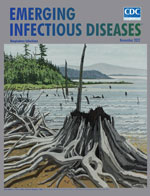
We investigated the proportion and characteristics of severe Corynebacterium striatum pneumonia in South Korea during 2014–2019. As part of an ongoing observational study of severe pneumonia among adult patients, we identified 27 severe C. striatum pneumonia cases. Most (70.4%) cases were hospital-acquired, and 51.9% of patients were immunocompromised. C. striatum cases among patients with severe hospital-acquired pneumonia (HAP) increased from 1.0% (2/200) during 2014–2015 to 5.4% (10/185) during 2018–2019, but methicillin-resistant Staphylococcus aureus (MRSA) infections among severe HAP cases decreased from 12.0% to 2.7% during the same timeframe. During 2018–2019, C. striatum was responsible for 13.3% of severe HAP cases from which bacterial pathogens were identified. The 90-day mortality rates were similarly high in the C. striatum and MRSA groups. C. striatum was a major cause of severe HAP and had high mortality rates. This pathogen is emerging as a possible cause for severe pneumonia, especially among immunocompromised patients.
| EID | Lee Y, Huh J, Hong S, Jung J, Kim M, Chong Y, et al. Severe Pneumonia Caused by Corynebacterium striatum in Adults, Seoul, South Korea, 2014–2019. Emerg Infect Dis. 2022;28(11):2147-2154. https://doi.org/10.3201/eid2811.220273 |
|---|---|
| AMA | Lee Y, Huh J, Hong S, et al. Severe Pneumonia Caused by Corynebacterium striatum in Adults, Seoul, South Korea, 2014–2019. Emerging Infectious Diseases. 2022;28(11):2147-2154. doi:10.3201/eid2811.220273. |
| APA | Lee, Y., Huh, J., Hong, S., Jung, J., Kim, M., Chong, Y....Choi, S. (2022). Severe Pneumonia Caused by Corynebacterium striatum in Adults, Seoul, South Korea, 2014–2019. Emerging Infectious Diseases, 28(11), 2147-2154. https://doi.org/10.3201/eid2811.220273. |
A multispecies outbreak of Nocardia occurred among heart transplant recipients (HTR), but not lung transplant recipients (LTR), in Sydney, New South Wales, Australia, during 2018–2019. We performed a retrospective review of 23 HTR and LTR who had Nocardia spp. infections during June 2015–March 2021, compared risk factors for Nocardia infection, and evaluated climate conditions before, during, and after the period of the 2018–2019 outbreak. Compared with LTR, HTR had a shorter median time from transplant to Nocardia diagnosis, higher prevalence of diabetes, greater use of induction immunosuppression with basiliximab, and increased rates of cellular rejection before Nocardia diagnosis. During the outbreak, Sydney experienced the lowest monthly precipitation and driest surface levels compared with time periods directly before and after the outbreak. Increased immunosuppression of HTR compared with LTR, coupled with extreme weather conditions during 2018–2019, may explain this outbreak of Nocardia infections in HTR.
| EID | Li J, Lau C, Anderson N, Burrows F, Mirdad F, Carlos L, et al. Multispecies Outbreak of Nocardia Infections in Heart Transplant Recipients and Association with Climate Conditions, Australia. Emerg Infect Dis. 2022;28(11):2155-2164. https://doi.org/10.3201/eid2811.220262 |
|---|---|
| AMA | Li J, Lau C, Anderson N, et al. Multispecies Outbreak of Nocardia Infections in Heart Transplant Recipients and Association with Climate Conditions, Australia. Emerging Infectious Diseases. 2022;28(11):2155-2164. doi:10.3201/eid2811.220262. |
| APA | Li, J., Lau, C., Anderson, N., Burrows, F., Mirdad, F., Carlos, L....Dharan, N. J. (2022). Multispecies Outbreak of Nocardia Infections in Heart Transplant Recipients and Association with Climate Conditions, Australia. Emerging Infectious Diseases, 28(11), 2155-2164. https://doi.org/10.3201/eid2811.220262. |
Volume 28, Number 10—October 2022
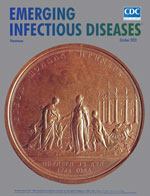
Tick-borne encephalitis (TBE) is a viral infection of the central nervous system that occurs in many parts of Europe and Asia. Humans mainly acquire TBE through tick bites, but TBE occasionally is contracted through consuming unpasteurized milk products from viremic livestock. We describe cases of TBE acquired through alimentary transmission in Europe during the past 4 decades. We conducted a systematic review and meta-analysis of 410 foodborne TBE cases, mostly from a region in central and eastern Europe. Most cases were reported during the warmer months (April–August) and were associated with ingesting unpasteurized dairy products from goats. The median incubation period was short, 3.5 days, and neuroinvasive disease was common (38.9%). The clinical attack rate was 14% (95% CI 12%–16%), and we noted major heterogeneity. Vaccination programs and public awareness campaigns could reduce the number of persons affected by this potentially severe disease.
| EID | Elbaz M, Gadoth A, Shepshelovich D, Shasha D, Rudoler N, Paran Y. Systematic Review and Meta-analysis of Foodborne Tick-Borne Encephalitis, Europe, 1980–2021. Emerg Infect Dis. 2022;28(10):1945-1954. https://doi.org/10.3201/eid2810.220498 |
|---|---|
| AMA | Elbaz M, Gadoth A, Shepshelovich D, et al. Systematic Review and Meta-analysis of Foodborne Tick-Borne Encephalitis, Europe, 1980–2021. Emerging Infectious Diseases. 2022;28(10):1945-1954. doi:10.3201/eid2810.220498. |
| APA | Elbaz, M., Gadoth, A., Shepshelovich, D., Shasha, D., Rudoler, N., & Paran, Y. (2022). Systematic Review and Meta-analysis of Foodborne Tick-Borne Encephalitis, Europe, 1980–2021. Emerging Infectious Diseases, 28(10), 1945-1954. https://doi.org/10.3201/eid2810.220498. |
Fungal infections cause substantial rates of illness and death. Interest in the association between demographic factors and fungal infections is increasing. We analyzed 2019 US hospital discharge data to assess factors associated with fungal infection diagnosis, including race and ethnicity and socioeconomic status. We found male patients were 1.5–3.5 times more likely to have invasive fungal infections diagnosed than were female patients. Compared with hospitalizations of non-Hispanic White patients, Black, Hispanic, and Native American patients had 1.4–5.9 times the rates of cryptococcosis, pneumocystosis, and coccidioidomycosis. Hospitalizations associated with lower-income areas had increased rates of all fungal infections, except aspergillosis. Compared with younger patients, fungal infection diagnosis rates, particularly for candidiasis, were elevated among persons >65 years of age. Our findings suggest that differences in fungal infection diagnostic rates are associated with demographic and socioeconomic factors and highlight an ongoing need for increased physician evaluation of risk for fungal infections.
| EID | Rayens E, Rayens M, Norris KA. Demographic and Socioeconomic Factors Associated with Fungal Infection Risk, United States, 2019. Emerg Infect Dis. 2022;28(10):1955-1969. https://doi.org/10.3201/eid2810.220391 |
|---|---|
| AMA | Rayens E, Rayens M, Norris KA. Demographic and Socioeconomic Factors Associated with Fungal Infection Risk, United States, 2019. Emerging Infectious Diseases. 2022;28(10):1955-1969. doi:10.3201/eid2810.220391. |
| APA | Rayens, E., Rayens, M., & Norris, K. A. (2022). Demographic and Socioeconomic Factors Associated with Fungal Infection Risk, United States, 2019. Emerging Infectious Diseases, 28(10), 1955-1969. https://doi.org/10.3201/eid2810.220391. |
Volume 28, Number 9—September 2022
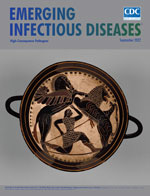
Invasive Haemophilus influenzae infection during pregnancy can cause preterm birth and fetal loss, but the mechanism is unclear. We investigated 54 cases of pregnancy-associated invasive H. influenzae disease in 52 unique pregnancies in the Auckland region of New Zealand during October 1, 2008‒September 30, 2018. Intraamniotic infection was identified in 36 (66.7%) of 54 cases. Outcome data were available for 48 pregnancies. Adverse pregnancy outcomes, defined as fetal loss, preterm birth, or the birth of an infant requiring intensive/special care unit admission, occurred in 45 (93.8%) of 48 (pregnancies. Fetal loss occurred in 17 (35.4%) of 48 pregnancies, before 24 weeks’ gestation in 13 cases, and at >24 weeks’ gestation in 4 cases. The overall incidence of pregnancy-associated invasive H. influenzae disease was 19.9 cases/100,000 births, which exceeded the reported incidence of pregnancy-associated listeriosis in New Zealand. We also observed higher rates in younger women and women of Māori ethnicity.
| EID | Hills T, Sharpe C, Wong T, Cutfield T, Lee A, McBride S, et al. Fetal Loss and Preterm Birth Caused by Intraamniotic Haemophilus influenzae Infection, New Zealand. Emerg Infect Dis. 2022;28(9):1747-1754. https://doi.org/10.3201/eid2809.220313 |
|---|---|
| AMA | Hills T, Sharpe C, Wong T, et al. Fetal Loss and Preterm Birth Caused by Intraamniotic Haemophilus influenzae Infection, New Zealand. Emerging Infectious Diseases. 2022;28(9):1747-1754. doi:10.3201/eid2809.220313. |
| APA | Hills, T., Sharpe, C., Wong, T., Cutfield, T., Lee, A., McBride, S....Thomas, M. (2022). Fetal Loss and Preterm Birth Caused by Intraamniotic Haemophilus influenzae Infection, New Zealand. Emerging Infectious Diseases, 28(9), 1747-1754. https://doi.org/10.3201/eid2809.220313. |
We investigated invasive group A Streptococcus epidemiology in Idaho, USA, during 2008–2019 using surveillance data, medical record review, and emm (M protein gene) typing results. Incidence increased from 1.04 to 4.76 cases/100,000 persons during 2008–2019. emm 1, 12, 28, 11, and 4 were the most common types, and 2 outbreaks were identified. We examined changes in distribution of clinical syndrome, patient demographics, and risk factors by comparing 2008–2013 baseline with 2014–2019 data. Incidence was higher among all age groups during 2014–2019. Streptococcal toxic shock syndrome increased from 0% to 6.4% of cases (p = 0.02). We identified no differences in distribution of demographic or risk factors between periods. Results indicated that invasive group A Streptococcus is increasing among the general population of Idaho. Ongoing surveillance of state-level invasive group A Streptococcus cases could help identify outbreaks, track regional trends in incidence, and monitor circulating emm types.
| EID | Dunne EM, Hutton S, Peterson E, Blackstock AJ, Hahn CG, Turner K, et al. Increasing Incidence of Invasive Group A Streptococcus Disease, Idaho, USA, 2008–2019. Emerg Infect Dis. 2022;28(9):1785-1795. https://doi.org/10.3201/eid2809.212129 |
|---|---|
| AMA | Dunne EM, Hutton S, Peterson E, et al. Increasing Incidence of Invasive Group A Streptococcus Disease, Idaho, USA, 2008–2019. Emerging Infectious Diseases. 2022;28(9):1785-1795. doi:10.3201/eid2809.212129. |
| APA | Dunne, E. M., Hutton, S., Peterson, E., Blackstock, A. J., Hahn, C. G., Turner, K....Carter, K. K. (2022). Increasing Incidence of Invasive Group A Streptococcus Disease, Idaho, USA, 2008–2019. Emerging Infectious Diseases, 28(9), 1785-1795. https://doi.org/10.3201/eid2809.212129. |
Volume 28, Number 8—August 2022
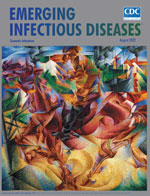
Since Mycoplasma genitalium was identified 40 years ago, much of the epidemiology has been described, diagnostic tests have been developed and approved, and recommended treatment approaches have been identified. However, the natural history remains incompletely understood, and antimicrobial resistance has rapidly increased. This review summarizes evidence published since the US Centers for Disease Control and Prevention 2015 Sexually Transmitted Diseases Treatment Guidelines. Data on sequelae remain insufficient, macrolide resistance is common, and fluoroquinolone resistance is increasing. Potential benefits of testing and treatment include resolving symptoms, interrupting transmission, and preventing sequelae. Potential harms include cost, patient anxiety, and increasing antimicrobial resistance.
| EID | Manhart LE, Geisler WM, Bradshaw CS, Jensen JS, Martin DH. Weighing Potential Benefits and Harms of Mycoplasma genitalium Testing and Treatment Approaches. Emerg Infect Dis. 2022;28(8):1-11. https://doi.org/10.3201/eid2808.220094 |
|---|---|
| AMA | Manhart LE, Geisler WM, Bradshaw CS, et al. Weighing Potential Benefits and Harms of Mycoplasma genitalium Testing and Treatment Approaches. Emerging Infectious Diseases. 2022;28(8):1-11. doi:10.3201/eid2808.220094. |
| APA | Manhart, L. E., Geisler, W. M., Bradshaw, C. S., Jensen, J. S., & Martin, D. H. (2022). Weighing Potential Benefits and Harms of Mycoplasma genitalium Testing and Treatment Approaches. Emerging Infectious Diseases, 28(8), 1-11. https://doi.org/10.3201/eid2808.220094. |
Ribavirin has been used widely to treat Lassa fever in West Africa since the 1980s. However, few studies have systematically appraised the evidence for its use. We conducted a systematic review of published and unpublished literature retrieved from electronic databases and gray literature from inception to March 8, 2022. We identified 13 studies of the comparative effectiveness of ribavirin versus no ribavirin treatment on mortality outcomes, including unpublished data from a study in Sierra Leone provided through a US Freedom of Information Act request. Although ribavirin was associated with decreased mortality rates, results of these studies were at critical or serious risk for bias when appraised using the ROBINS-I tool. Important risks for bias related to lack of control for confounders, immortal time bias, and missing outcome data. Robust evidence supporting the use of ribavirin in Lassa fever is lacking. Well-conducted clinical trials to elucidate the effectiveness of ribavirin for Lassa fever are needed.
| EID | Cheng H, French CE, Salam AP, Dawson S, McAleenan A, McGuinness LA, et al. Lack of Evidence for Ribavirin Treatment of Lassa Fever in Systematic Review of Published and Unpublished Studies. Emerg Infect Dis. 2022;28(8):1559-1568. https://doi.org/10.3201/eid2808.211787 |
|---|---|
| AMA | Cheng H, French CE, Salam AP, et al. Lack of Evidence for Ribavirin Treatment of Lassa Fever in Systematic Review of Published and Unpublished Studies. Emerging Infectious Diseases. 2022;28(8):1559-1568. doi:10.3201/eid2808.211787. |
| APA | Cheng, H., French, C. E., Salam, A. P., Dawson, S., McAleenan, A., McGuinness, L. A....Sterne, J. (2022). Lack of Evidence for Ribavirin Treatment of Lassa Fever in Systematic Review of Published and Unpublished Studies. Emerging Infectious Diseases, 28(8), 1559-1568. https://doi.org/10.3201/eid2808.211787. |
Volume 28, Number 7—July 2022
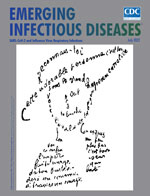
We combined American Community Survey data with age-specific Trypanosoma cruzi prevalence derived from US surveys and World Health Organization reports to yield estimates of Chagas disease in the United States, which we mapped at the local level. In addition, we used blood donor data to estimate the relative prevalence of autochthonous T. cruzi infection. Our estimates indicate that 288,000 infected persons, including 57,000 Chagas cardiomyopathy patients and 43,000 infected reproductive-age women, currently live in the United States; 22–108 congenital infections occur annually. We estimated ≈10,000 prevalent cases of locally acquired T. cruzi infection. Mapping shows marked geographic heterogeneity of T. cruzi prevalence and illness. Reliable demographic and geographic data are key to guiding prevention and management of Chagas disease. Population-based surveys in high prevalence areas could improve the evidence base for future estimates. Knowledge of the demographics and geographic distribution of affected persons may aid practitioners in recognizing Chagas disease.
| EID | Irish A, Whitman JD, Clark EH, Marcus R, Bern C. Updated Estimates and Mapping for Prevalence of Chagas Disease among Adults, United States. Emerg Infect Dis. 2022;28(7):1313-1320. https://doi.org/10.3201/eid2807.212221 |
|---|---|
| AMA | Irish A, Whitman JD, Clark EH, et al. Updated Estimates and Mapping for Prevalence of Chagas Disease among Adults, United States. Emerging Infectious Diseases. 2022;28(7):1313-1320. doi:10.3201/eid2807.212221. |
| APA | Irish, A., Whitman, J. D., Clark, E. H., Marcus, R., & Bern, C. (2022). Updated Estimates and Mapping for Prevalence of Chagas Disease among Adults, United States. Emerging Infectious Diseases, 28(7), 1313-1320. https://doi.org/10.3201/eid2807.212221. |
Serum agglutination test plus exposure history were used to diagnose most cases of human brucellosis in 2 China provinces. After appropriate treatment, 13.3% of acute brucellosis cases progressed to chronic disease; arthritis was an early predictor. Seropositivity can persist after symptoms disappear, which might cause physicians to subjectively extend therapeutic regimens.
| EID | Wang H, Liu H, Zhang Q, Lu X, Li D, Zhang H, et al. Natural History of and Dynamic Changes in Clinical Manifestation, Serology, and Treatment of Brucellosis, China. Emerg Infect Dis. 2022;28(7):1460-1465. https://doi.org/10.3201/eid2807.211766 |
|---|---|
| AMA | Wang H, Liu H, Zhang Q, et al. Natural History of and Dynamic Changes in Clinical Manifestation, Serology, and Treatment of Brucellosis, China. Emerging Infectious Diseases. 2022;28(7):1460-1465. doi:10.3201/eid2807.211766. |
| APA | Wang, H., Liu, H., Zhang, Q., Lu, X., Li, D., Zhang, H....Zhang, W. (2022). Natural History of and Dynamic Changes in Clinical Manifestation, Serology, and Treatment of Brucellosis, China. Emerging Infectious Diseases, 28(7), 1460-1465. https://doi.org/10.3201/eid2807.211766. |
Volume 28, Number 6—June 2022
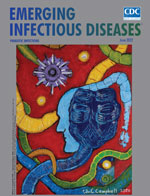
Demographic and clinical indicators have been described to support identification of coccidioidomycosis; however, the interplay of these conditions has not been explored in a clinical setting. In 2019, we enrolled 392 participants in a cross-sectional study for suspected coccidioidomycosis in emergency departments and inpatient units in Coccidioides-endemic regions. We aimed to develop a predictive model among participants with suspected coccidioidomycosis. We applied a least absolute shrinkage and selection operator to specific coccidioidomycosis predictors and developed univariable and multivariable logistic regression models. Univariable models identified elevated eosinophil count as a statistically significant predictive feature of coccidioidomycosis in both inpatient and outpatient settings. Our multivariable outpatient model also identified rash (adjusted odds ratio 9.74 [95% CI 1.03–92.24]; p = 0.047) as a predictor. Our results suggest preliminary support for developing a coccidioidomycosis prediction model for use in clinical settings.
| EID | Ramadan FA, Ellingson KD, Canales RA, Bedrick EJ, Galgiani JN, Donovan FM. Cross-Sectional Study of Clinical Predictors of Coccidioidomycosis, Arizona, USA. Emerg Infect Dis. 2022;28(6):1091-1100. https://doi.org/10.3201/eid2806.212311 |
|---|---|
| AMA | Ramadan FA, Ellingson KD, Canales RA, et al. Cross-Sectional Study of Clinical Predictors of Coccidioidomycosis, Arizona, USA. Emerging Infectious Diseases. 2022;28(6):1091-1100. doi:10.3201/eid2806.212311. |
| APA | Ramadan, F. A., Ellingson, K. D., Canales, R. A., Bedrick, E. J., Galgiani, J. N., & Donovan, F. M. (2022). Cross-Sectional Study of Clinical Predictors of Coccidioidomycosis, Arizona, USA. Emerging Infectious Diseases, 28(6), 1091-1100. https://doi.org/10.3201/eid2806.212311. |
Annually, Shigella spp. cause ≈188 million cases of diarrheal disease globally, including 500,000 cases in the United States; rates of antimicrobial resistance are increasing. To determine antimicrobial resistance and risk factors in San Diego, California, USA, we retrospectively reviewed cases of diarrheal disease caused by Shigella flexneri and S. sonnei diagnosed during 2017–2020. Of 128 evaluable cases, S. flexneri was slightly more common than S. sonnei; most cases were in persons who were gay or bisexual cisgender men, were living with HIV, were unhoused, or used methamphetamines. Overall, rates of resistance to azithromycin, fluoroquinolones, ampicillin, and trimethoprim/sulfamethoxazole (TMP/SMX) were comparable to the most recent national data reported from the Centers for Disease Control and Prevention; 55% of isolates were resistant to azithromycin, 23% to fluoroquinolones, 70% to ampicillin, and 83% to TMP/SMX. The rates that we found for TMP/SMX were slightly higher than those in national data.
| EID | Gaufin T, Blumenthal J, Ramirez-Sanchez C, Mehta S, Pride DT, Fierer J, et al. Antimicrobial-Resistant Shigella spp. in San Diego, California, USA, 2017–2020. Emerg Infect Dis. 2022;28(6):1110-1116. https://doi.org/10.3201/eid2806.220131 |
|---|---|
| AMA | Gaufin T, Blumenthal J, Ramirez-Sanchez C, et al. Antimicrobial-Resistant Shigella spp. in San Diego, California, USA, 2017–2020. Emerging Infectious Diseases. 2022;28(6):1110-1116. doi:10.3201/eid2806.220131. |
| APA | Gaufin, T., Blumenthal, J., Ramirez-Sanchez, C., Mehta, S., Pride, D. T., Fierer, J....Jenks, J. D. (2022). Antimicrobial-Resistant Shigella spp. in San Diego, California, USA, 2017–2020. Emerging Infectious Diseases, 28(6), 1110-1116. https://doi.org/10.3201/eid2806.220131. |
Volume 28, Number 5—May 2022
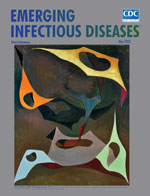
Healthcare-associated invasive group A Streptococcus (iGAS) outbreaks are common worldwide, but only England has reported outbreaks associated with home healthcare (HHC). We describe 10 outbreaks during 2018–2019 in England. A total of 96 iGAS cases (range 2–39 per outbreak) and 28 deaths (case-fatality rate 29%) occurred. Outbreak duration ranged from 3–517 days; median time between sequential cases was 20.5 days (range 1–225 days). Outbreak identification was difficult, but emm typing and whole-genome sequencing improved detection. Network analyses indicated multiple potential transmission routes. Screening of 366 HHC workers from 9 outbreaks identified group A Streptococcus carriage in just 1 worker. Outbreak control required multiple interventions, including improved infection control, equipment decontamination, and antimicrobial prophylaxis for staff. Transmission routes and effective interventions are not yet clear, and iGAS outbreaks likely are underrecognized. To improve patient safety and reduce deaths, public health agencies should be aware of HHC-associated iGAS.
| EID | Nabarro LE, Brown CS, Balasegaram S, Decraene V, Elston J, Kapadia S, et al. Invasive Group A Streptococcus Outbreaks Associated with Home Healthcare, England, 2018–2019. Emerg Infect Dis. 2022;28(5):915-923. https://doi.org/10.3201/eid2805.211497 |
|---|---|
| AMA | Nabarro LE, Brown CS, Balasegaram S, et al. Invasive Group A Streptococcus Outbreaks Associated with Home Healthcare, England, 2018–2019. Emerging Infectious Diseases. 2022;28(5):915-923. doi:10.3201/eid2805.211497. |
| APA | Nabarro, L. E., Brown, C. S., Balasegaram, S., Decraene, V., Elston, J., Kapadia, S....Lamagni, T. (2022). Invasive Group A Streptococcus Outbreaks Associated with Home Healthcare, England, 2018–2019. Emerging Infectious Diseases, 28(5), 915-923. https://doi.org/10.3201/eid2805.211497. |
We describe the global molecular epidemiology of 229 carbapenemase-producing Escherichia coli in 36 countries during 2015–2017. Common carbapenemases were oxacillinase (OXA) 181 (23%), New Delhi metallo-β-lactamase (NDM) 5 (20%), OXA-48 (17%), Klebsiella pneumoniae carbapenemase 2 (15%), and NDM-1 (10%). We identified 5 dominant sequence types (STs); 4 were global (ST410, ST131, ST167, and ST405), and 1 (ST1284) was limited to Turkey. OXA-181 was frequent in Jordan (because of the ST410-B4/H24RxC subclade) and Turkey (because of ST1284). We found nearly identical IncX3-blaOXA-181 plasmids among 11 STs from 12 countries. NDM-5 was frequent in Egypt, Thailand (linked with ST410-B4/H24RxC and ST167-B subclades), and Vietnam (because of ST448). OXA-48 was common in Turkey (linked with ST11260). Global K. pneumoniae carbapenemases were linked with ST131 C1/H30 subclade and NDM-1 with various STs. The global carbapenemase E. coli population is dominated by diverse STs with different characteristics and varied geographic distributions, requiring ongoing genomic surveillance.
| EID | Peirano G, Chen L, Nobrega D, Finn TJ, Kreiswirth BN, DeVinney R, et al. Genomic Epidemiology of Global Carbapenemase-Producing Escherichia coli, 2015–2017. Emerg Infect Dis. 2022;28(5):924-931. https://doi.org/10.3201/eid2805.212535 |
|---|---|
| AMA | Peirano G, Chen L, Nobrega D, et al. Genomic Epidemiology of Global Carbapenemase-Producing Escherichia coli, 2015–2017. Emerging Infectious Diseases. 2022;28(5):924-931. doi:10.3201/eid2805.212535. |
| APA | Peirano, G., Chen, L., Nobrega, D., Finn, T. J., Kreiswirth, B. N., DeVinney, R....Pitout, J. (2022). Genomic Epidemiology of Global Carbapenemase-Producing Escherichia coli, 2015–2017. Emerging Infectious Diseases, 28(5), 924-931. https://doi.org/10.3201/eid2805.212535. |
Volume 28, Number 4—April 2022
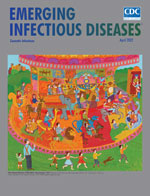
The epidemiology of bloodstream infections caused by Shewanella spp. is not well defined. Our objective was to define the incidence and determinants of Shewanella spp. bloodstream infections by using population-based surveillance in Queensland, Australia during 2000‒2019. The incidence was 1.0 cases/1 million persons annually and was highest during summer and in the tropical Torres and Cape region. Older persons and male patients were at highest risk. At least 1 concurrent condition was documented in 75% of case-patients, and 30-day all cause case-fatality rate was 15%. Aging populations in warm climates might expect an increasing burden of these infections.
| EID | Laupland KB, Stewart AG, Edwards F, Paterson DL, Coulter S, Heney C, et al. Shewanella spp. Bloodstream Infections in Queensland, Australia. Emerg Infect Dis. 2022;28(4):701-706. https://doi.org/10.3201/eid2804.212193 |
|---|---|
| AMA | Laupland KB, Stewart AG, Edwards F, et al. Shewanella spp. Bloodstream Infections in Queensland, Australia. Emerging Infectious Diseases. 2022;28(4):701-706. doi:10.3201/eid2804.212193. |
| APA | Laupland, K. B., Stewart, A. G., Edwards, F., Paterson, D. L., Coulter, S., Heney, C....Harris, P. (2022). Shewanella spp. Bloodstream Infections in Queensland, Australia. Emerging Infectious Diseases, 28(4), 701-706. https://doi.org/10.3201/eid2804.212193. |
Lyme neuroborreliosis (LNB) in Europe may manifest with painful meningoradiculoneuritis (also known as Bannwarth syndrome) or lymphocytic meningitis with or without cranial neuritis (peripheral facial palsy). We assessed host immune responses and the prevalence of TLR1 (toll-like receptor 1)–1805GG polymorphism to gain insights into the pathophysiology of these conditions. Regardless of LNB manifestation, most mediators associated with innate and adaptive immune responses were concentrated in cerebrospinal fluid; serum levels were unremarkable. When stratified by specific clinical manifestation, patients with meningoradiculoneuritis had higher levels of B-cell chemoattractants CXC motif chemokine ligand (CXCL) 12 and CXCL13 and T-cell–associated mediators CXCL9, CXCL10, and interleukin 17, compared with those without radicular pain. Moreover, these patients had a higher frequency of TLR1–1805GG polymorphism and more constitutional symptoms. These findings demonstrate that meningoradiculoneuritis is a distinct clinical entity with unique immune and genetic pathophysiology, providing new considerations for the study of LNB and borrelial meningoradiculitis.
| EID | Ogrinc K, Hernández SA, Korva M, Bogovič P, Rojko T, Lusa L, et al. Unique Clinical, Immune, and Genetic Signature in Patients with Borrelial Meningoradiculoneuritis. Emerg Infect Dis. 2022;28(4):766-776. https://doi.org/10.3201/eid2804.211831 |
|---|---|
| AMA | Ogrinc K, Hernández SA, Korva M, et al. Unique Clinical, Immune, and Genetic Signature in Patients with Borrelial Meningoradiculoneuritis. Emerging Infectious Diseases. 2022;28(4):766-776. doi:10.3201/eid2804.211831. |
| APA | Ogrinc, K., Hernández, S. A., Korva, M., Bogovič, P., Rojko, T., Lusa, L....Strle, K. (2022). Unique Clinical, Immune, and Genetic Signature in Patients with Borrelial Meningoradiculoneuritis. Emerging Infectious Diseases, 28(4), 766-776. https://doi.org/10.3201/eid2804.211831. |
Volume 28, Number 3—March 2022
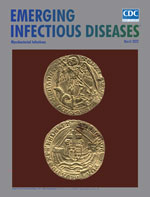
Enterovirus D68 (EV-D68) causes severe respiratory illness outbreaks among children, particularly those with asthma. We previously detected neutralizing antibodies against the predominant EV-D68 B1 clade in the 2014 outbreak in serum collected before the outbreak (2012–2013) from persons 24 months to 85 years of age. We recently detected neutralizing antibodies to the 2014 B1, B2, and D clade viruses in serum collected after the 2014 outbreak (April–May 2017) from 300 children 6 months to 18 years of age. B1 virus neutralizing antibodies were found in 100% of patients, even children born after 2014; B2 in 84.6%, and D in 99.6%. In 2017, titers increased with patient age and were higher than titers in 2012–2013 from comparably aged children. Rate of seronegativity was highest (15.3%) for B2 virus. Multivariate analysis revealed an association between asthma and higher titers against B2 and D viruses. EV-D68 seems to have circulated during 2014–2017.
| EID | Livingston RA, Harrison CJ, Selvarangan R. Neutralizing Enterovirus D68 Antibodies in Children after 2014 Outbreak, Kansas City, Missouri, USA. Emerg Infect Dis. 2022;28(3):539-547. https://doi.org/10.3201/eid2803.211467 |
|---|---|
| AMA | Livingston RA, Harrison CJ, Selvarangan R. Neutralizing Enterovirus D68 Antibodies in Children after 2014 Outbreak, Kansas City, Missouri, USA. Emerging Infectious Diseases. 2022;28(3):539-547. doi:10.3201/eid2803.211467. |
| APA | Livingston, R. A., Harrison, C. J., & Selvarangan, R. (2022). Neutralizing Enterovirus D68 Antibodies in Children after 2014 Outbreak, Kansas City, Missouri, USA. Emerging Infectious Diseases, 28(3), 539-547. https://doi.org/10.3201/eid2803.211467. |
Reported Legionnaires’ disease (LD) cases began increasing in the United States in 2003 after relatively stable numbers for >10 years; reasons for the rise are unclear. We compared epidemiologic patterns associated with cases reported to the Centers for Disease Control and Prevention before and during the rise. The age-standardized average incidence was 0.48 cases/100,000 population during 1992–2002 compared with 2.71 cases/100,000 in 2018. Reported LD incidence increased in nearly every demographic, but increases tended to be larger in demographic groups with higher incidence. During both periods, the largest number of cases occurred among White persons, but the highest incidence was in Black or African American persons. Incidence and increases in incidence were generally largest in the East North Central, Middle Atlantic, and New England divisions. Seasonality was more pronounced during 2003–2018, especially in the Northeast and Midwest. Rising incidence was most notably associated with increasing racial disparities, geographic focus, and seasonality.
| EID | Barskey AE, Derado G, Edens C. Rising Incidence of Legionnaires’ Disease and Associated Epidemiologic Patterns, United States, 1992–2018. Emerg Infect Dis. 2022;28(3):527-538. https://doi.org/10.3201/eid2803.211435 |
|---|---|
| AMA | Barskey AE, Derado G, Edens C. Rising Incidence of Legionnaires’ Disease and Associated Epidemiologic Patterns, United States, 1992–2018. Emerging Infectious Diseases. 2022;28(3):527-538. doi:10.3201/eid2803.211435. |
| APA | Barskey, A. E., Derado, G., & Edens, C. (2022). Rising Incidence of Legionnaires’ Disease and Associated Epidemiologic Patterns, United States, 1992–2018. Emerging Infectious Diseases, 28(3), 527-538. https://doi.org/10.3201/eid2803.211435. |
Volume 28, Number 2—February 2022
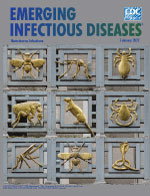
Information on febrile illness caused by tick-borne encephalitis virus (TBEV) without central nervous system involvement is limited. We characterized 98 patients who had TBEV RNA in their blood but no central nervous system involvement at the time of evaluation. Median duration of illness was 7 days; 37 (38%) patients were hospitalized. The most frequent findings were malaise or fatigue (98%), fever (97%), headache (86%), and myalgias (54%); common laboratory findings were leukopenia (88%), thrombocytopenia (59%), and abnormal liver test results (63%). During the illness, blood leukocyte counts tended to improve, whereas thrombocytopenia and liver enzymes tended to deteriorate. At the time of positive PCR findings, 0/98 patients had serum IgG TBEV and 7 serum IgM TBEV; all patients later seroconverted. Viral RNA load was higher in patients with more severe illness but did not differ substantially in relation to several other factors. Illness progressed to tick-borne encephalitis in 84% of patients within 18 days after defervescence.
| EID | Bogovič P, Kastrin A, Lotrič-Furlan S, Ogrinc K, Županc T, Korva M, et al. Clinical and Laboratory Characteristics and Outcome of Illness Caused by Tick-Borne Encephalitis Virus without Central Nervous System Involvement. Emerg Infect Dis. 2022;28(2):291-301. https://doi.org/10.3201/eid2802.211661 |
|---|---|
| AMA | Bogovič P, Kastrin A, Lotrič-Furlan S, et al. Clinical and Laboratory Characteristics and Outcome of Illness Caused by Tick-Borne Encephalitis Virus without Central Nervous System Involvement. Emerging Infectious Diseases. 2022;28(2):291-301. doi:10.3201/eid2802.211661. |
| APA | Bogovič, P., Kastrin, A., Lotrič-Furlan, S., Ogrinc, K., Županc, T., Korva, M....Strle, F. (2022). Clinical and Laboratory Characteristics and Outcome of Illness Caused by Tick-Borne Encephalitis Virus without Central Nervous System Involvement. Emerging Infectious Diseases, 28(2), 291-301. https://doi.org/10.3201/eid2802.211661. |
Babesia spp. are tickborne parasites that cause the clinical infection babesiosis, which has an increasing incidence in the United States. We performed an analysis of hospitalizations in the United States during 2010–2016 in which babesiosis was listed as a diagnosis. We used the National Inpatient Sample database to characterize the epidemiology of Babesia–associated admissions, reflecting severe Babesia-related disease. Over a 7-year period, a total of 7,818 hospitalizations listed babesiosis as a primary or secondary admitting diagnosis. Hospitalizations were seasonal (71.2% occurred during June–August) and situated overwhelmingly in the Northeast and Midwest. The patients were predominantly male and of advanced age, which is consistent with the expected epidemiology. Despite a higher severity of illness in more than (58.5%), the mortality rate was low (1.6%). Comparison with state reporting data suggests that the number of hospitalized persons with babesiosis increased modestly during the observation period.
| EID | Bloch EM, Day JR, Krause PJ, Kjemtrup A, O’Brien SF, Tobian A, et al. Epidemiology of Hospitalized Patients with Babesiosis, United States, 2010–2016. Emerg Infect Dis. 2022;28(2):354-362. https://doi.org/10.3201/eid2802.210213 |
|---|---|
| AMA | Bloch EM, Day JR, Krause PJ, et al. Epidemiology of Hospitalized Patients with Babesiosis, United States, 2010–2016. Emerging Infectious Diseases. 2022;28(2):354-362. doi:10.3201/eid2802.210213. |
| APA | Bloch, E. M., Day, J. R., Krause, P. J., Kjemtrup, A., O’Brien, S. F., Tobian, A....Goel, R. (2022). Epidemiology of Hospitalized Patients with Babesiosis, United States, 2010–2016. Emerging Infectious Diseases, 28(2), 354-362. https://doi.org/10.3201/eid2802.210213. |
Volume 28, Number 1—January 2022
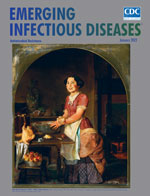
Since 2012, the United States has reported a distinct syndrome of acute flaccid paralysis (AFP) with anterior myelitis, predominantly in children. This polio-like syndrome was termed acute flaccid myelitis (AFM). Australia routinely conducts AFP surveillance to exclude poliomyelitis. We reviewed 915 AFP cases in Australia for children <15 years of age during 2000‒2018 and reclassified a subset to AFM by using the US Council of State and Territorial Epidemiologists case definition. We confirmed 37 AFM cases by using magnetic resonance imaging findings and 4 probable AFM cases on the basis of cerebrospinal fluid pleocytosis. Nonpolio enteroviruses were detected in 33% of AFM cases from which stool samples were tested. Average annual AFM incidence was 0.07 cases/100,000 person-years in children <15 years of age. AFM occurred sporadically in Australia before 2010 but regularly since then, indicating sustained, albeit rare, clinical manifestation in children. The AFP surveillance system in Australia is well-positioned to identify future AFM cases.
| EID | Walker LJ, Thorley BR, Morris A, Elliott EJ, Saul N, Britton PN. Using the Acute Flaccid Paralysis Surveillance System to Identify Cases of Acute Flaccid Myelitis, Australia, 2000‒2018. Emerg Infect Dis. 2022;28(1):20-28. https://doi.org/10.3201/eid2801.211690 |
|---|---|
| AMA | Walker LJ, Thorley BR, Morris A, et al. Using the Acute Flaccid Paralysis Surveillance System to Identify Cases of Acute Flaccid Myelitis, Australia, 2000‒2018. Emerging Infectious Diseases. 2022;28(1):20-28. doi:10.3201/eid2801.211690. |
| APA | Walker, L. J., Thorley, B. R., Morris, A., Elliott, E. J., Saul, N., & Britton, P. N. (2022). Using the Acute Flaccid Paralysis Surveillance System to Identify Cases of Acute Flaccid Myelitis, Australia, 2000‒2018. Emerging Infectious Diseases, 28(1), 20-28. https://doi.org/10.3201/eid2801.211690. |
Rare fungal pathogens are emerging as agents of invasive fungal infections. We analyzed 13 cases of fungal infections caused by Kazachstania (Arxiozyma) spp. in Strasbourg University Hospital, Strasbourg, France. Among the cases, 4 patients had proven fungal disease (3 cases of invasive fungal disease and 1 mucocutaneous infection) and 9 were colonized by Kazachstania (Arxiozyma) spp. Candida albicans was also isolated from 11 of the 13 patients. None of the patients with proven invasive fungal disease met host criteria, but most had underlying diseases. All strains were identified as K. telluris by matrix-assisted laser desorption/ionization time-of-flight mass spectrometry, and 3 were confirmed as K. bovina by internal transcribed spacer sequencing. For all tested strains, the MICs for fluconazole were >2 μg/mL. Emergence of this rare fungal infection might be explained by the increasing number of patients with immunocompromised conditions and gastroesophageal diseases.
| EID | Kaeuffer C, Baldacini M, Ruge T, Ruch Y, Zhu Y, De Cian M, et al. Fungal Infections Caused by Kazachstania spp., Strasbourg, France, 2007–2020. Emerg Infect Dis. 2022;28(1):29-34. https://doi.org/10.3201/eid2801.211543 |
|---|---|
| AMA | Kaeuffer C, Baldacini M, Ruge T, et al. Fungal Infections Caused by Kazachstania spp., Strasbourg, France, 2007–2020. Emerging Infectious Diseases. 2022;28(1):29-34. doi:10.3201/eid2801.211543. |
| APA | Kaeuffer, C., Baldacini, M., Ruge, T., Ruch, Y., Zhu, Y., De Cian, M....Danion, F. (2022). Fungal Infections Caused by Kazachstania spp., Strasbourg, France, 2007–2020. Emerging Infectious Diseases, 28(1), 29-34. https://doi.org/10.3201/eid2801.211543. |
CME Articles by Volume




